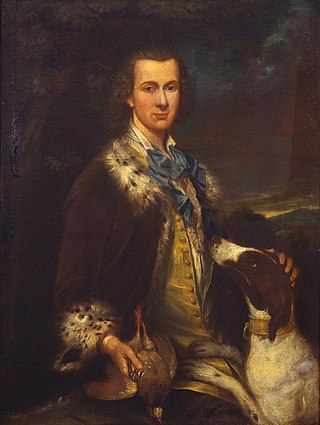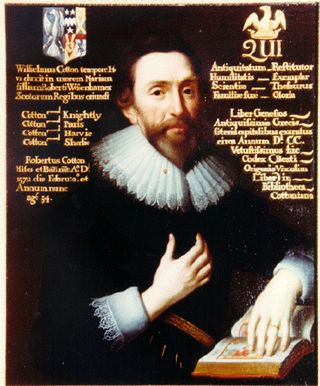
Earl of Limerick is a title that has been created twice in the Peerage of Ireland, associated first with the Dongan family, then with the Pery family. It should not be confused with the title Viscount of the City of Limerick held by the Hamilton family also Earls of Clanbrassil.

Viscount de Vesci, of Abbeyleix in the Queen's County, now called County Laois, is a title in the Peerage of Ireland. It was created in 1776 for Thomas Vesey, 2nd Baron Knapton and 3rd Baronet. The title Baron Knapton was created in the Peerage of Ireland in 1750 for the first Viscount's father, John Vesey, 2nd Baronet, who had earlier represented Newtownards in the Irish House of Commons. The baronetcy, of Abbeyleix in the Queen's County, was created in the Baronetage of Ireland on 28 September 1698 for the first Baron's father, Reverend Thomas Vesey, Bishop of Killaloe (1713–1714) and Bishop of Ossory (1714–1730).

There have been three Baronetcies created for persons with the surname Cotton, all in the Baronetage of England. One creation is extant as of 2008.
There have been ten baronetcies created for persons with the surname Browne, six in the Baronetage of Great Britain, three in the Baronetage of Ireland and one in the Baronetage of Nova Scotia. Only one creation is extant as of 2010. Three of the creations were for members of the Browne family headed by the Viscount Montagu.

Viscount Mountmorres was a title in the Peerage of Ireland. It was created on 29 June 1763 for Hervey Morres, 1st Baron Mountmorres, who had previously represented St Canice in the Irish House of Commons. He had been created Baron Mountmorres, of Castlemorres in the County of Kilkenny, on 4 May 1756, also in the Peerage of Ireland. He was the grandson of Hervey Morres, member of the Irish Parliament for Knocktopher, younger son of Sir Redmond Morres, 2nd Baronet, of Knockagh. Lord Mountmorres was succeeded by his son from his first marriage, the second Viscount. In 1795 he also succeeded his kinsman as 10th Baronet of Knockagh. He was succeeded in both the baronetcy and peerages by his half-brother, the third Viscount. He assumed in 1815 by Royal licence the surname of de Montmorency in lieu of Morres. On his death the titles passed to his son, the fourth Viscount. He was Dean of Cloyne and Dean of Achonry. The titles descended from father to son until the death of his grandson, the sixth Viscount, in 1936. The late Viscount was succeeded by his first cousin, the seventh Viscount. He was the son of the Hon. Arthur de Montmorency, fourth son of the fourth Viscount. He had no male issue and on his death in 1951 the barony and viscountcy became extinct.

Viscount Frankfort de Montmorency, of Galmoye in the County of Kilkenny, was a title in the Peerage of Ireland. It was created on 22 January 1816 for Lodge de Montmorency, 1st Baron Frankfort, who had earlier represented Bandon Bridge, Dingle, Inistioge and Ennis in the Irish House of Commons. He had already been made Baron Frankfort, of Galmoye in the County of Kilkenny, on 31 July 1800, also in the Peerage of Ireland. Born Lodge Evans Morres, he assumed in 1815 by Royal licence the surname of de Montmorency in lieu of Morres. However, the French House of de Montmorency never recognised his claim to be a member of that house. His grandson, the third Viscount, was a Major-General in the British Army and sat in the House of Lords as an Irish representative peer between 1900 and 1902. The latter's eldest son, the Honourable Raymond de Montmorency, was awarded the Victoria Cross for his actions at the Battle of Omdurman in 1898. He was killed in action in the Second Boer War two years later, predeceasing his father by two years. The third Viscount was succeeded by his second and only surviving son, the fourth Viscount. He was also a soldier. He died childless in 1917 when the titles became extinct.

There have been five baronetcies created for people with the surname Pollock, one in the Baronetage of Nova Scotia and four in the Baronetage of the United Kingdom. As of 2017 three of the creations are extant. These three creations derive from the same family to which the 1703 baronetcy was granted; the Pollock ancestor of Sir Frederick Pollock, 1st Baronet, and Sir George Pollock, 1st Baronet, married his cousin, daughter of Sir Robert Pollock, 2nd Baronet.

There have been three baronetcies created for members of the Ingilby/Ingleby family, one in the Baronetage of England, one in the Baronetage of Great Britain and one in the Baronetage of the United Kingdom. The latter title is extant while the other two creations are extinct.
There have been three baronetcies created for persons with the surname Bellingham, one in the Baronetage of England, one in the Baronetage of Ireland and one in the Baronetage of Great Britain. As of 2014 one creation is extant.
There have been five baronetcies created for persons with the surname Evans, one in the Baronetage of Ireland and four in the Baronetage of the United Kingdom. All of the baronetcies are now extinct.
There have been four baronetcies created for people with the surname Parsons, two in the Baronetage of Ireland, one in the Baronetage of England and one in the Baronetage of the United Kingdom. One creation is still extant as of 2008.
Brabazon Ponsonby, 1st Earl of Bessborough, was a British politician and peer. He was the son of William Ponsonby, 1st Viscount Duncannon, and Mary Moore. He was an active politician from 1705 to 1757 in Great Britain and Ireland. He represented Newtownards and County Kildare in the Irish House of Commons. He inherited his father's viscountcy in 1724 and was made Earl of Bessborough in the Peerage of Ireland in 1739. He is buried in Fiddown, County Kilkenny, Ireland.

Lodge Evans de Montmorency, 1st Viscount Frankfort de Montmorency PC, known as Lodge Morres until 1800 and as The Lord Frankfort between 1800 and 1816, was an Irish politician.
The High Sheriff of County Kilkenny was the British Crown's judicial representative in County Kilkenny, Ireland from the 16th century until 1922, when the office was abolished in the new Free State and replaced by the office of Kilkenny County Sheriff. The sheriff had judicial, electoral, ceremonial and administrative functions and executed High Court Writs. In 1908, an Order in Council made the Lord-Lieutenant the Sovereign's prime representative in a county and reduced the High Sheriff's precedence. However, the sheriff retained his responsibilities for the preservation of law and order in the county. The usual procedure for appointing the sheriff from 1660 onwards was that three persons were nominated at the beginning of each year from the county and the Lord Lieutenant then appointed his choice as High Sheriff for the remainder of the year. Often the other nominees were appointed as under-sheriffs. Sometimes a sheriff did not fulfil his entire term through death or other event and another sheriff was then appointed for the remainder of the year. The dates given hereunder are the dates of appointment. All addresses are in County Kilkenny unless stated otherwise.
There have been three baronetcies created for persons with the surname Duncan, one in the Baronetage of Great Britain and two in the Baronetage of the United Kingdom. All three creations are extinct.
Hervey Morres, 1st Viscount Mountmorres, was an Irish landowner and politician.

Earl of Arran is a title in the Peerage of Ireland. It is not to be confused with the title Earl of Arran in the Peerage of Scotland. The two titles refer to different places: the Aran Islands in Ireland, and the Isle of Arran in Scotland. The Irish earldom is held by the Gore family. The Scottish earldom is a separate title, held as a subsidiary title of the Duke of Hamilton.
Sir William Evans Morres, 1st Baronet was an Anglo-Irish politician.
Sir William Evans Ryves de Montmorency, 3rd Baronet was an Anglo-Irish politician.
Hervey Redmond Morres, 2nd Viscount of Mountmorres was an Anglo-Irish politician and writer.









